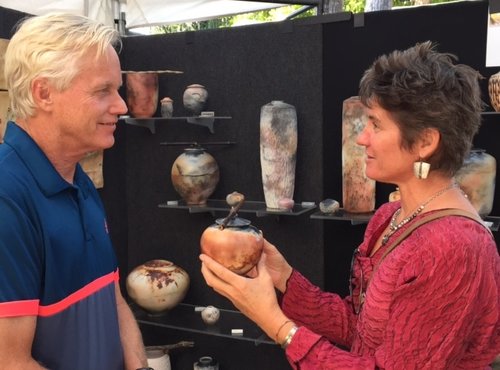by Carolyn Edlund
Understanding the demographics and motivations of your target customers can help you build relationships and increase sales.

Ceramic artist Brenda McMahon speaks with a potential collector
Most people do not purchase original art or fine craft; instead, they most often buy commercially manufactured items. They may prefer shopping at a mall, or ordering online from big brands. That’s OK, though. These people aren’t your customers. You don’t have to worry about them, because you will be focusing on and marketing to the specific customer that you do want to attract.
On the other hand, there are plenty of customers who specifically want to own handmade work. They have a true appreciation for the talent and experience of the maker and the creativity behind each piece. These shoppers consider themselves highly selective because they are searching for objects that aren’t mass-produced, common or even readily available. They choose to buy something unique and different, and they do this purposefully and consistently. This reflects their values, and what they consider to be of value to themselves personally.
Why They Buy
Buying handmade says a lot about this customer. It reflects their self-perception and what they want others to think of them. When they purchase and give a handmade gift, it sends a very special message to the recipient about their taste and generosity, and the importance of the relationship.
People who buy handmade in general tend to be well-educated. They also may be talented and creative people themselves, but instead of making art or craft, they express themselves through collecting. These buyers value the aesthetic, the authenticity, and the work ethic behind handmade items. They admire the lifestyle and freedom of the artist. Many wish to support artists whose work reflects their stance on social and world issues. They do this through acquisition, as well as extending patronage through sites like Patreon.
Purchasing handmade work allows the collector to own a piece of your creativity and your artistic vision. When they speak to others about their purchase, they will often indicate that they’ve met the artist. They will tell others your artist story and talk about the source of your inspiration. This is very meaningful to collectors and is an important part of the ownership experience.
Identify Your Ideal Customer
Take a closer look at your audience by creating a profile of the ideal customer. You will know who you want to appeal to when you choose an audience to design for. Test the appeal of your work by getting in front of customers at a fair, studio sale, trunk show or other event where you meet people face to face. You can learn a lot from customers, so ask questions and listen to them. Who responds to your art, touching or trying pieces on? Where are they from, and why do they find your work so appealing?
To create a target customer profile, you must know as much as possible about them. Gather information that helps describe your customer. These are called demographics, and may include:
- age group
- education
- approximate household income
- lifestyle preferences
- location (urban, suburban, rural)
- religion
- marital and family status
You will also want to gather information about your customer’s attitudes, aspirations, hobbies, spending habits and values. These are called “psychographics” and they help to round out the customer profile.
Here’s an example of a profile that a jewelry artist created. She has come to understand very clearly the type of customer who loves what she makes.
“My target customer is a woman in her late 20’s to 40’s, living in an urban setting. She is a well-educated and well-paid professional, either in law, or in a helping profession. She may travel for her job and is upwardly mobile. Quite often, she is a single career woman or is divorced, and usually childless, with disposable income. Her interests lie in being noticed for a very individual style and owning unusual jewelry, but she still wants a classic enough look to wear to the office and have something that is timeless. She is involved with charitable causes or women’s issues, and values being recognized as an individual. She attends cultural events, loves city living, and wears mid-range designer clothing. Her spending habits on jewelry reveal an average purchase of $175.00. She wants to own sets and collect from certain artists she knows, and will plan and save up for a larger purchase. She also buys handmade clothing and handbags, and likes to be associated with the arts and creative people, whom she admires.”
As you come to know your own ideal customers, you can design for them, communicate effectively with them about their lives and their tastes, and speak easily to them in conversation. That makes the purchase of your handmade work very personal for the shopper, and enables you to cultivate a relationship with them that encourages collecting and repeat business.


[…] to be your own boss and set your own rates and prices, but since more people are always looking for handmade goods, this is a great business idea to get […]